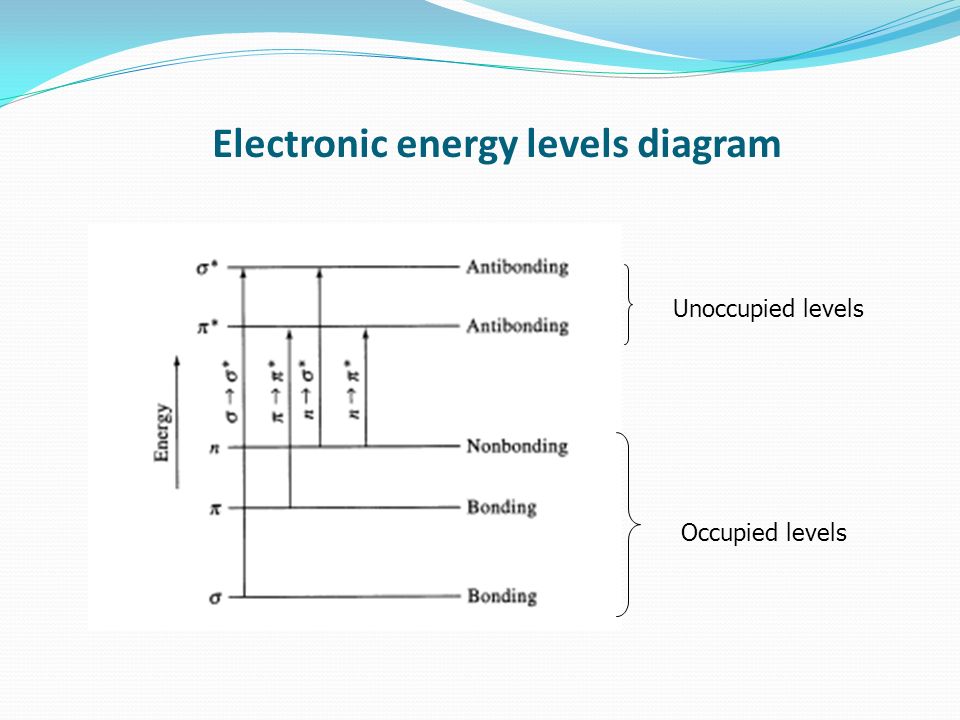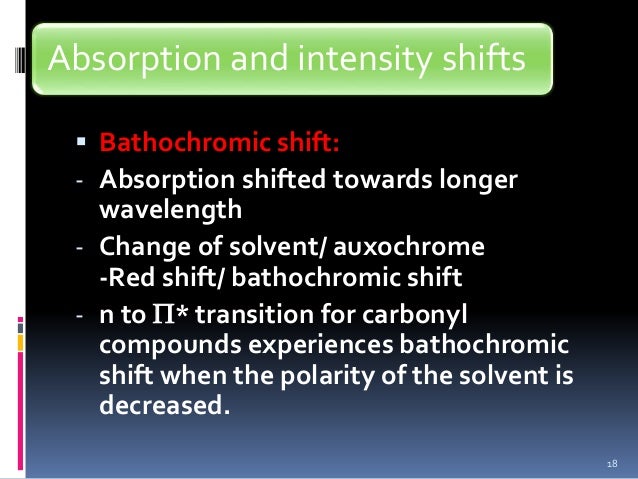- Bathochromic shift: In spectroscopy, the position shift of a peak or signal to longer wavelength (lower energy). Also called a red shift. A hypsochromic shift is the shift of a peak or signal to shorter wavelength (higher energy). Also called a blue shift.
- Hypsochromic shift or blue shift In a similar way, shift of λmax to the shorter wavelengths is termed as hypsochromic shift. This shift results when the energy gap between HOMO and LUMO is increased due to any situations like stabilization of HOMO.
Chromophore
It is a covalently unsaturated group which is responsible for absorption of UV or visible radiation and may or may not impact in colour to the compound.
A compound which contains chromophore it is called chromogen.
In unsaturated linkage such as -c=c- ,
3: Luminescence sensitization of Es was achieved on chelation by HOPO, confirming the +3 oxidation state for Es and revealing an unusual hypsochromic shift in metal emission.
-N=N-, the π electron are loosely bound. These loosely bound electron required less energy for electronic transition and the absorption band occur in near UV region.
Example Acetylene possessed -C=C- in structure it λmax is 175-180 nm.
Auxo chrome
It is saturated and unsaturated group which consists of one or more pair of non-bonded electron.

This group is attached to Chromophore help in altering the wavelength by increasing the intensity of absorption and increase λmax.
Example of Auxochrome is -OH, -NH2,

-OR etc.
Type of Shift
1. Bathochromic shift ( Red shift ) :-
In this Types the absorption maximum shift towards longer wavelength.
When two or more chromophore present in a molecule is responsible for bathochromic shift.
Ex. Ethene which contain unconjugated double bond show λmax at 170 nm.
2. Hypsochromic shift ( Blue shift) :-
In this Type the absorption maximum shift towards shorter wavelength. This shift is occur due to removal of conjugation or due to change in the polarity of the solvent.
Ex. Aniline show λmax at 280 nm because of on conjugation between lone pair of electron between nitrogen and benzene.
3. Hyperchromic shift :-
In this Type of shift increase intensity with increase of absorption of radiation.
This is due to the introduce Auxochrome.
Ex. Increase intensity of the absorption of DNA due to denaturation at the λmax 260 nm.
4. Hypochromic shift :–
In this Type of shift decrease intensity of radiation because of decreased absorption.
It is due to presence of certain group which may cause deformation of structure of compound.
MCQ
1. Which statement is false about Chromophore ?
A. It is co-valent unsaturated compound.
B. It is contain π electron.
C. They required high energy for electron transition.
D. They required low energy for electron transition.
2. Which statement is true about Auxochrome ?
A. It is only saturated compound.
B. It is only unsaturated compound.
C. It is Decreased intensity of radiation.
D. They are saturated and unsaturated compound.
3. Which group act as a Chromophore?
A. -N=N-
B. -OH
C. -OR
D.- NH2
4. DNA denaturation is example of which type of shift ?
A. Bathochromic
B. Blue shift
C. Hyperchromic shift
D. Red shift
5. λmax increase with absorption of radiation in which shift ?
A. Red shift

B. Blue shift
C. A and B
D. None of this
6. Due to deformation of compound due to attached some other functional group it is example of
A. Red shift
B. Blue shift
C. Hyperchromic shift
D. Hypochromic shift
7. Auxochrome have which type of electron ?

A. Non bonded
B. π electron
C.σ electron
D. None of this
Answer key
1. C
2. D
3. A
4. C
5. A
6. C
7. A
Hypsochromic Shifts
The Occurrence of Hypsochromic Shifts on Alkyl Substitution: Structure and Color of Methylated Derivatives of Azulene
Abstract
While two methylated derivatives of azulene show the usual bathochromic shift with respect to azulene itself, the remaining three isomers show an unusual displacement of the visible spectrum toward shorter wave-lengths. No steric effects can be claimed to account for these last results which are considered as representing genuine hypsochromic shifts brought about by alkyl substitution and due to the particularities of the structure of azulene and its derivatives. It is then shown by molecular orbital method calculations that Mulliken's N→V theory of color accounts satisfactorily for the observed facts. In the methylated derivatives showing a bathochromic shift, the calculated excitation energy of the N→VI transition appears to be smaller than the corresponding energy in azulene itself, while the reverse is true for the compounds exhibiting a hypsochromic shift. The general conditions necessary for the occurence of hypsochromic shifts upon alkylation and a few predictions of such shifts in other hydrocarbons are given.
Hypsochromic Shift Example
Hypsochromic Shift Example
- Publication:
- Pub Date:
- March 1950
- DOI:
- 10.1063/1.1747616
- Bibcode:
- 1950JChPh..18..257P
